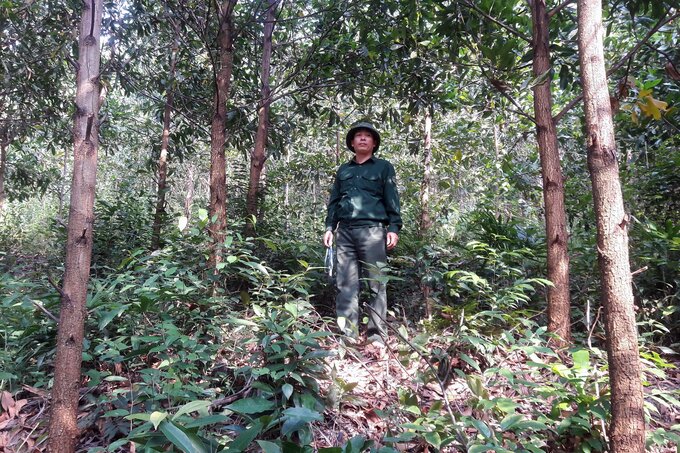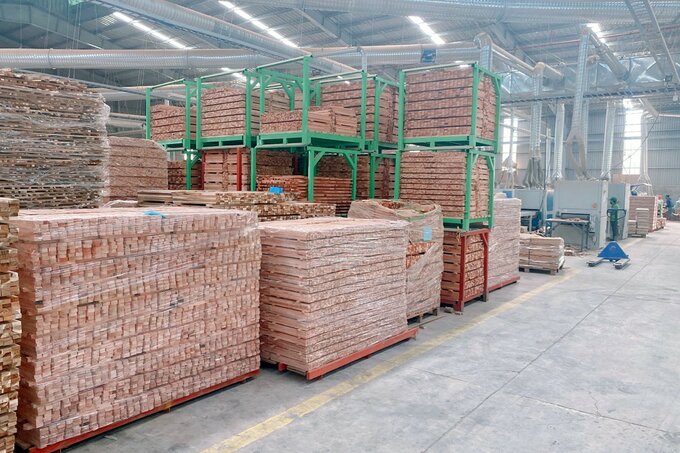Selling young forests and consequences for large timber forest
(VAN) Price of planted timber has reached a historic peak. As a result, young forests will be cut, Binh
The open-door policy in Quang Tri in recent years has attracted many individuals and businesses to invest and build wood chipping factories in service of export. Up to the present date, the whole province has over 25 factories and dozens of plywood and wood billet factories put into operation. Approximately 100 km from the Vietnam - Laos border there is also a pulp factory from China with a capacity of 1.5 million tons/year which has been in commercial operation since 2018. The current conditions are considered very ideal to invest in planting large timber forests with the intention of supplying raw materials for factories.
Small timber forests serving the woodchip industry, which possess low economic value, are making life difficult for forest growers in Quang Tri. Photo: Vo Dung.
According to a representative of MDF VRG - Quang Tri Wood Joint Stock Company, the competition in the raw material purchasing market has become increasingly fierce especially in terms of prices and purchasing methods. This creates positive impacts for forest growers but also unintentionally causes forest growers to exploit the forest when the trees are not yet mature. This leads to an increase in the consumption of raw materials per 1 m3 of product, hence an increase in product prices.
Faced with this situation, a representative of MDF VRG - Quang Tri Wood Joint Stock Company said that the State needed to support forest growers in terms of capital to maintain forests until they reach adulthood to truly become large timber forests with a lot of better quality and higher value wood.
Mr. Ho Xuan Hieu, Chairman of the Board of Directors of Quang Tri General Trading Joint Stock Company (Sepon Group), said that planted forest timber posed no problem considering the output market, but the key point was to improve the product value. “Exporting products made from planted forest timber is the most effective solution. Planting FSC certified large timber forests is therefore the path to take.”
State supports and the companionship of enterprises are essential for forest growers to harness their confidence and invest in planting large timber forests. Photo: Vo Dung.
According to Mr. Hieu, the woodchip industry is the largest gateway to consuming output products for planted forest timber, and Vietnam is one of the largest exporters of wood chips in the world. Another thing is that Vietnam's woodworking export industry thrives in the context of increasingly limited timber resources from Laos and the closure of timber harvest from natural forests. This also contributes to further increasing the planted forest area.
The market for planted forest materials is becoming more and more active thanks to the increase of various different types of wood products such as fiberboard, MDF (medium density fibreboard), and peeled board. In recent years, wood pellets – a biomass fuel that partially replaces fossil fuels, have exploited at maximum the output from planted forests as well as by-products from the wood processing industry.
However, Mr. Hieu believed that it was necessary to choose the direction that possesses the highest efficiency for the development of planted forest timber in Quang Tri. "In the minds of the vast majority of forest growers, with an investment of VND 15 million/ha (seedlings, fertilizers, labor, etc.), they can sell timber at an average of VND 60 million/ha after 4 years, gaining a profit of approximately VND 45 million/ha. Forest growers can thus both reduce the risk of natural disasters, forest fires and quickly collect money (two 8-year cycles means an income of approximately VND 90 million/ha). If they plan to plant a large timber forest with the same initial investment, after 8 years, they can sell for at least VND 130-200 million/ha, earn at least VND 115-185 million/ha. But the capital recovery time is slow, so the risk is high, which is something to carefully consider.”
The wood industry of Vietnam in general and Quang Tri in particular will mark its position in the international arena if the forest is developed in a sustainable direction. Photo: Vo Dung.
Mr. Hieu proposed a number of solutions. Wood processing enterprises should create opportunities to meet and have a conversation so that forest growers can understand the advantages and disadvantages of wood materials supplied from their forests.
Wood processing enterprises need to accompany forest growers to fulfill their commitment to practice large timber afforestation. Strong commitments to accompany people are also required when there is a potential risk of natural disasters as well as adverse fluctuations from the consumption market. Forest growers themselves need to raise awareness concerning the practice of large timber afforestation as well as the implementation of commitments to accompany businesses to avoid the situation of breaking the link in the market, causing damage to enterprises.
Translated by Samuel Pham


